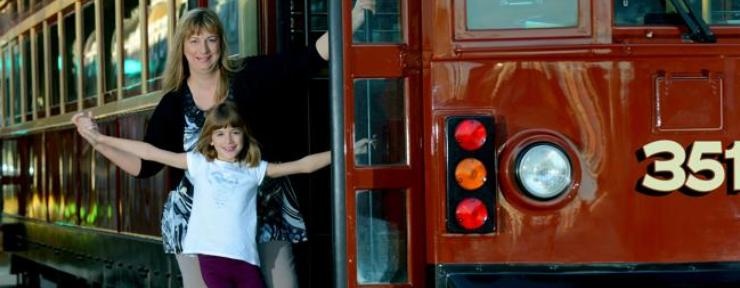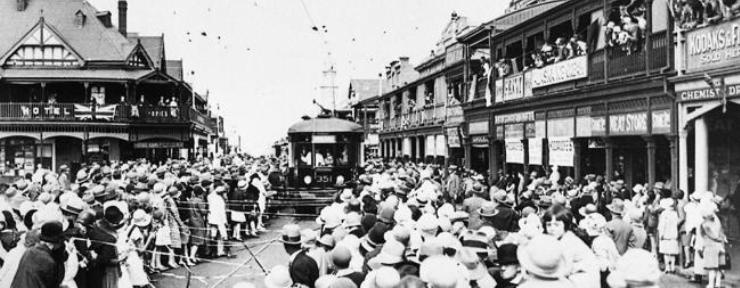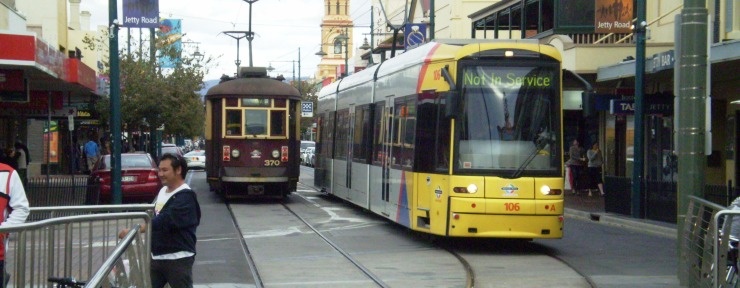➔ Book Now - Best Rates Guaranteed!
H Class Tram returns to the bay!
Posted by Craig Leverenz on 3 August 2013 | 5 Comments
ONE of the state's much-loved heritage red rattler trams is returning to Glenelg.
The H-Class tram will return to service tomorrow, Sunday, August 4, after undergoing a $70,000 refurbishment.
Tram H351 - which carried the first passengers along the Glenelg tramline when it was launched in December 1929 - will operate each Sunday throughout August, leaving from Glenelg at 11am and 1pm and from the Adelaide Entertainment Centre at noon and 2pm.
Passengers will be asked to give a gold coin donation to offset the tram's running cost, and will receive a special heritage-style ticket in return.
The tram will run on August 4, 11, 18 and 24. It will not be disability-accessible.
The Glenelg Tram
The Glenelg Tram is a 15-kilometre (9.3 mi) route in South Australia from Hindmarsh, through the centre of Adelaide, to the beach-side suburb of Glenelg. It is Adelaide's only remaining tramway, running at approximately 15-minute intervals, and is part of the integrated Adelaide Metro public transport network. The service is free between the Entertainment Centre in Hindmarsh and South Terrace in the City, and along the entire length of Jetty Road in Glenelg. Apart from short street-running sections in Adelaide city centre and Glenelg, the Glenelg route is in a private reservation, enabling a fast and reliable service with minimal interference from road traffic.
1929-vintage H-class cars provided all services on the Glenelg line until January 2006, when the first members of a new fleet of modern Flexity Classic trams entered service. Eleven 30m-long articulated low-floor Light Rail vehicles, built by Bombardier in Germany now operate the service.
Construction of a 1.6 kilometres (1.0 mi) extension from Victoria Square, along King William Street and North Terrace to Morphett Street started in April 2007. The extension opened to the public on 14 October 2007. A new bridge over South Road to replace the existing crossing opened on 15 March 2010 and a further 2.8 km extension of the line along Port Road to the Entertainment Centre was opened on 22 March 2010. There are plans to extend the tramway even further to Port Adelaide, Semaphore, Woodville and West Lakes.
History of the Glenelg Tram
The route was built in 1873 by a private company, the Adelaide, Glenelg & Suburban Railway Company Ltd. The original line had a very different character to today’s route.
- It was similar to Adelaide's other suburban train lines.
- It was built to the 5 ft 3 in (1,600 mm) broad gauge. (Today’s tram is 4 ft 8 1⁄2 in (1,435 mm).
- It was operated by steam locomotives not electric trams.
- Most of the localities between Glenelg and Adelaide were sparsely settled and undeveloped. The line ran through open paddocks and market gardens.
- The line was largely single track.
- It crossed the Main South Line at Goodwood by a flat crossing, not an overpass.
- There were fewer stopping points and these were at conventional railway stations.
- It ran in competition with the North Terrace – Glenelg railway line
- The trains did not operate on anything like the frequency of today’s trams, and a timetable was certainly advisable when planning a journey.
In December 1899 the private company was acquired by the state government-controlled South Australian Railways (SAR), who continued to operate the line as a steam railway for the next 30 years or so. In 1914, the railway’s terminus was cut back from the edge of Victoria Square (in the centre of Adelaide) to South Terrace on the city’s southern fringe. Passengers had to transfer to electric trams to complete their journey into the city.
In 1929 ownership and operation transferred from the SAR to Adelaide’s Municipal Tramways Trust (MTT). Steam trains ceased on 2 April 1929 and the line was closed to be rebuilt to standard gauge, electrified at 600 V dc and converted to tramway operation. The Goodwood flyover was constructed at this time, separating the new tram tracks from the conventional railway.
Thirty H-class trams were built for the line by a local manufacturer, A. Pengelley, along the lines of North American interurban cars of that era. The line re-opened on 14 December 1929, with the city terminus reverting to Victoria Square.
There were one or two quirks in the earlier years, the most famous being the “horse trams” operated in the 1930s. These were trams specially constructed to carry race horses from stables located along the line to the racecourse at Morphettville. This service was a carry-over from the days of the steam railway, which had also performed this function. Another unusual feature was operation of triple sets of H-class trams in peak hours, and express trams that ran non-stop over a significant portion of the route. In 2006, only one express service remained.
The line was the only route to survive the closure of Adelaide’s street tramway network during the 1950s, saved largely by its high proportion of reserved track, which enables fast journey for passengers and minimal interference from and to road traffic.
The H-class cars were progressively updated during the 1970s, again in the late 1980s and most recently (on five trams) in 2000. These included toughened safety glass in windows, replacing wooden panels with fibreglass, upgrading bogies, fluorescent lights inside the cars, and sealed-beam headlights and brake/hazard lamp clusters outside.
In 1986 the line was converted from trolley pole to pantograph operation. This change coincided with relocation of the tram depot from the corner of Angas Street and Victoria Square in central Adelaide to a new facility at Glengowrie, close to Glenelg.
Despite the various refurbishments and upgrades, the overall character of the H-class trams has stayed very much as they were built. The interiors are still varnished wood and glass etched with MTT logos, and with no heating or air conditioning. Central doors initially divided the carriages into a smoking section for men and a non-smoking section for women. The divider still remains although smoking is no longer allowed on the tram. Any remaining services are crew operated, with a driver and conductor on single cars, or a driver and two conductors on two-car sets.
Post your comment
Posting comments has been disabled.
Comments
-
I was brought up in Adelaide and return regularly from Wollongong to visit friends and relatives.
I am unable to comprehend why Adelaide ceased running its historical, efficient, comfortable and reliable H-class trams. These H-class trams aided tourism in Adelaide more than any other feature and were recognized throughout the world as unique.
In terms of comfort the H-class were ergonomic for passengers who sat in upholstered seats rather than the limited uncomfortable rigid molded fibreglass seating of the successors. Furthermore, I recall years ago seeing two and three set cars running charters and services to the Bay! What flexibility.
Adelaide, your pollies have done you a dis-service. Get a few more back again!Posted by Peter Cannell, 29/07/2014 2:57am (10 years ago)
-
Love the trams, they really make a day trip to the bay so worthit for visitors and locals alike. Thanks for the blog, it's a great way to reach out to potential visitors. We recommend you to all our friends from inter state :)
Posted by Mark, 27/03/2014 8:10am (10 years ago)
-
The term red rattler is a modern one as before 1970 they were silver and red along the side only and nobody called them rattlers. Nobody was left standing at the stops either which seems common enough these days, perhaps the authorities should be told that coupled H types carried double the amount of passengers, thats what happens when coupled sets are replaced by single trams.
Posted by Ronald Reiman, 31/01/2014 10:05pm (10 years ago)
-
When I see what has happened to City Depot, when I see the shemozzlle that is Glengowrie, when I see perfectly good Htypes being dumped here and there, when I think of the years that I worked on them, to see what has happened to them, I find it difficult to hold back tears. John Bannon, Mike Rann may you be cursed forever. 1822 Motorman, retired MTT.
Posted by Ronald Reiman, 09/01/2014 6:50pm (10 years ago)
-
I'll comment, then, as I've done elsewhere. I say link Rann's idea of a city tram loop and the restoration of all together. Build the loop and run the H-type on it with some of them also running them to Glenelg.
Don't wait on the State Government - pay for the trams and tracks by public subscription. Let EVERYBODY who can, put in $10 (at the State Bank) that should raise about $8 million, for a start.
If that's not then another $10 can be raised down the line. We are not talking about big money to most people by any means! Remember once these trams are gone - like the double-decker trolley buses - they are gone.
The H-type on a city loop will give a highly visible nostalgic colour to the streets whilst enhancing tourism, commerce and adjacent property values.
IT'S UP TO YOU PEOPLE OF ADELAIDE, DON'T LOSE TIME WITH WISHFUL THINKING -DO SOMETHING!Posted by stewart, 04/10/2013 12:59pm (11 years ago)




